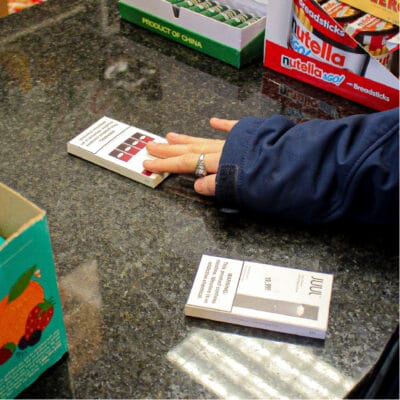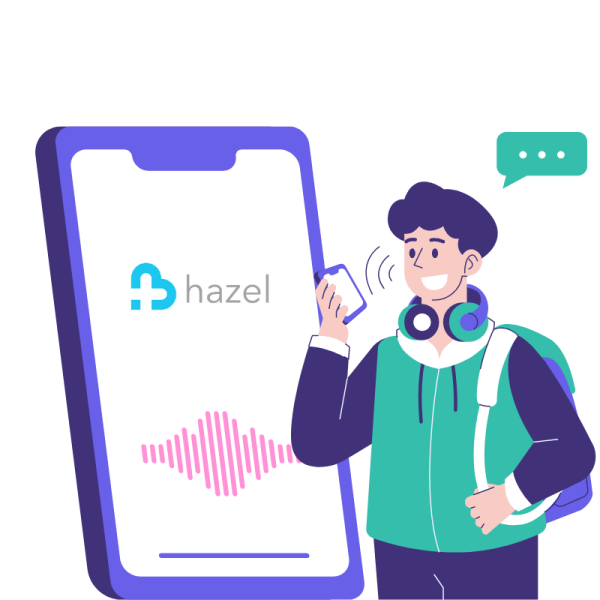Inspired by the work of Dr. Danielle Ramo, Hopelab’s former Senior Director of Research and an expert in teen vaping and other substance use, we are developing an approach to vaping cessation that leverages our in-house expertise, core competencies in behavioral science and design, and a practice of co-creating with teens to ensure a first-hand understanding of the vaping cessation experience. Dr. Ramo’s research over the last 15 years has been grounded in understanding the effects of digital interventions on substance use, and shows that treatments delivered over social media can have promising effects in reaching young people where they are and in helping them make positive changes like quitting smoking. You can learn more about this intervention here.
Using Technology to Talk Vaping
 With youth vaping as a significant public health concern—including its implications for physical health, mental health, and COVID-associated risks—leveraging technology can be an important strategy to help support and promote healthy behaviors among young people. Technology-based solutions have the potential to be far-reaching, especially during shelter-in-place, and social media in particular can deliver engaging intervention material directly to teens in a medium that is already deeply integrated into their lives.
With youth vaping as a significant public health concern—including its implications for physical health, mental health, and COVID-associated risks—leveraging technology can be an important strategy to help support and promote healthy behaviors among young people. Technology-based solutions have the potential to be far-reaching, especially during shelter-in-place, and social media in particular can deliver engaging intervention material directly to teens in a medium that is already deeply integrated into their lives.
Parents and guardians play a pivotal role in shaping children’s beliefs about substance use. Moreover, they can help their teenagers to stop using if they become dependent. In their role as trusted caretakers, they can share information about the dangers of vaping and other critical resources about quitting, whether their teens are known to be vaping or not.
Because finding reliable resources to facilitate a dialogue with young people about the hazards of vaping can be daunting, Hopelab, in collaboration with All Mental Health and the American Heart Association, has developed a resource to help parents and caregivers have informed, productive, and nuanced conversations with their teens. “Talk Vaping With Your Teen” is a comprehensive resource that provides what parents cited they needed most—the latest and most trusted information about vaping, practical tips for having effective conversations with their teens, and techniques to remain grounded when discussing and coping with such a high-stress topic. This resource is now part of the Truth Initiative’s BecomeAnEX program and can be accessed here under resources for parents and adults.
For Teens, By Teens
 The good news is that teens want to quit. To directly tackle vaping cessation among young people, our team is co-designing an intervention specifically for teens who have expressed a desire to quit, and/or who are getting ready to quit. To date, we’ve conducted comprehensive listening sessions with over 200 teens to learn more about their lives and their experiences vaping. Co-created with young people who have both vaping and quitting experience, we have developed a tool that will encourage and support other young people to quit vaping, enabling them to ‘on-ramp’ to a path toward health and well-being.
The good news is that teens want to quit. To directly tackle vaping cessation among young people, our team is co-designing an intervention specifically for teens who have expressed a desire to quit, and/or who are getting ready to quit. To date, we’ve conducted comprehensive listening sessions with over 200 teens to learn more about their lives and their experiences vaping. Co-created with young people who have both vaping and quitting experience, we have developed a tool that will encourage and support other young people to quit vaping, enabling them to ‘on-ramp’ to a path toward health and well-being.
This important work is being developed in collaboration with Rescue Agency, a San Diego, CA digital marketing firm with expertise in smoking cessation interventions, and the UCSF Center for Tobacco Control Research and Education (CTCRE), a leading scientific voice against practices that undermine science at the expense of human lives. Much like in the early days of traditional cigarette research, very little is known about the health effects of vaping. However, what is known largely comes out of the research from the UCSF CTCRE. The combined core competencies of this partnership bring to bear a mix of deep research expertise, co-creation design processes, and dynamic outreach capabilities.
There are many ways to impact the health and happiness of young people. Our foundational experience in teen vaping and cessation research provides unique insight into why young people start to vape, why they continue, and strategies to support their journey toward vaping cessation. Together, this body of knowledge undergirds a rigorous product design and co-creation process and reflects our nearly 20-year commitment to developing behavior-change tech that supports teens and young adults to live healthier lives.

 Not surprisingly, the pandemic has introduced further concern:
Not surprisingly, the pandemic has introduced further concern:  Vaping can also be dangerous for mental health, especially for young people. The
Vaping can also be dangerous for mental health, especially for young people. The  With youth vaping as a significant public health concern—including its implications for physical health, mental health, and COVID-associated risks—leveraging technology can be an important strategy to help support and promote healthy behaviors among young people. Technology-based solutions have the potential to be far-reaching, especially during shelter-in-place, and social media in particular can deliver engaging intervention material directly to teens in a medium that is already deeply integrated into their lives.
With youth vaping as a significant public health concern—including its implications for physical health, mental health, and COVID-associated risks—leveraging technology can be an important strategy to help support and promote healthy behaviors among young people. Technology-based solutions have the potential to be far-reaching, especially during shelter-in-place, and social media in particular can deliver engaging intervention material directly to teens in a medium that is already deeply integrated into their lives. The good news is that
The good news is that 


